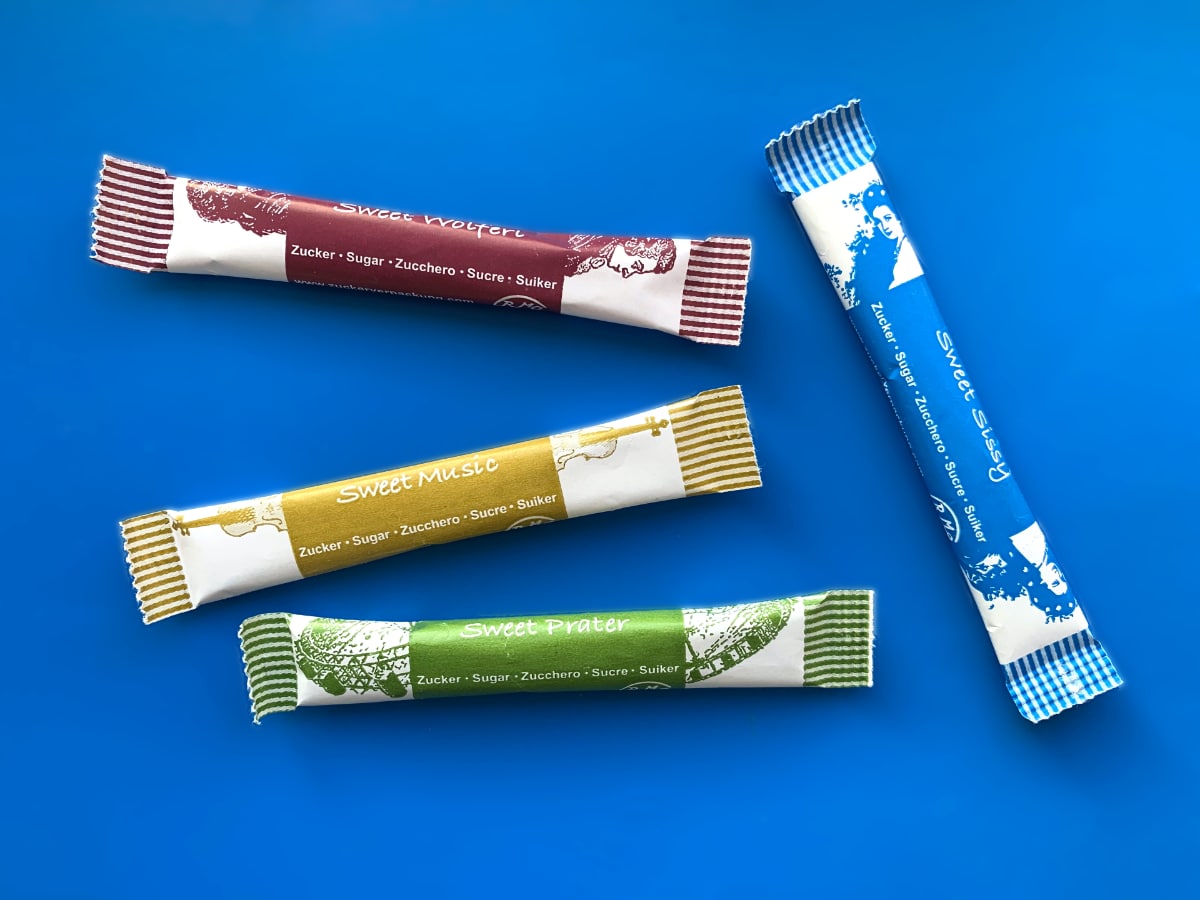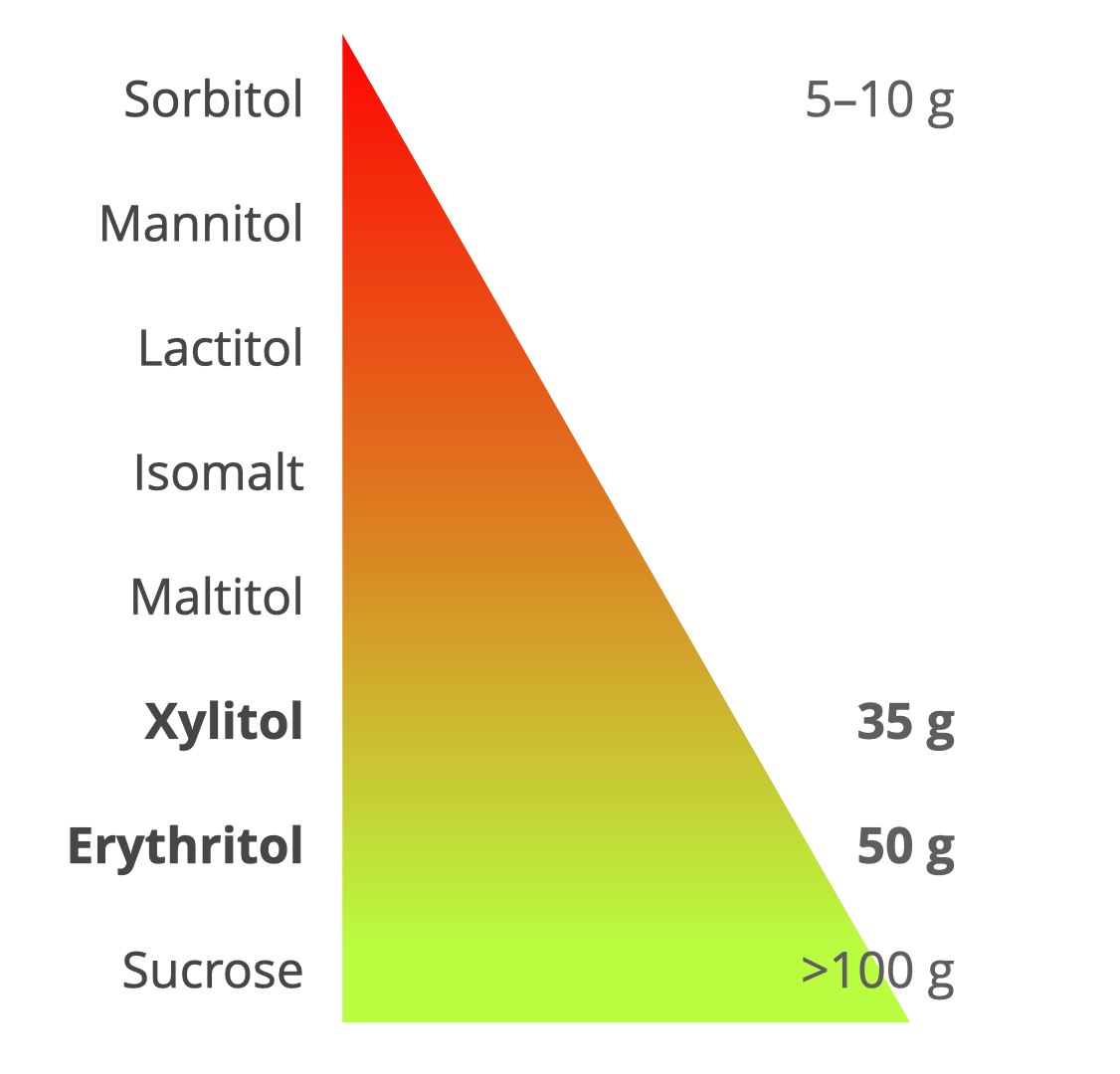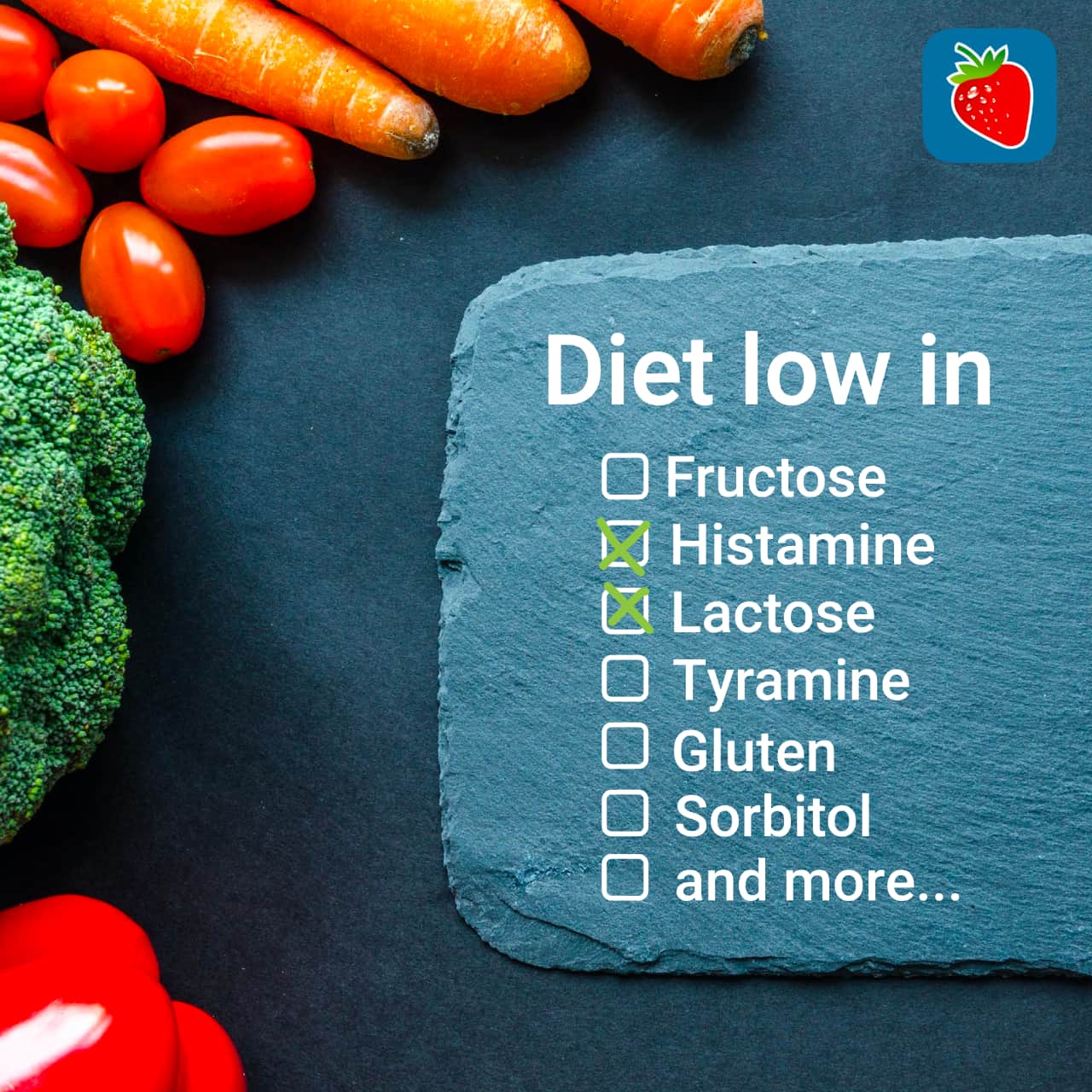Erythritol, xylitol, and stevia: an answer to fructose intolerance?
03/26/2021 Food Intolerances OxiPur
People with a fructose intolerance are often reluctant to consume foods containing sucrose, the chemical name for table sugar, since the compound consists of 50% fructose (and 50% glucose). Instead, sufferers opt for expensive sugar substitutes that are often specifically marketed as fructose-free alternatives. Here we take a closer look at three substitutes – xylitol, erythritol, and stevia – and assess their pros and cons compared to regular household sugar.

Common to all three sugar substitutes mentioned is the degree to which they cause blood sugar levels to rise: from negligibly to not at all. For diabetics, this certainly makes them attractive options. Xylitol and erythritol are sugar alcohols, while stevia is a calorie-free sweetener. It is also common to find coconut sugar, whose composition is similar to table sugar or honey, as a viable sugar substitute.
Some sugar alcohols are absorbed passively and very slowly in the gut and are not safe to consume in large quantities. For this reason, most sugar alternatives are based on xylitol and erythritol, which remain among the best tolerated sugar alcohols.
Table sugar is universally available and most importantly, extremely cheap, but this is definitely not the case with most sugar alternatives, whose manufacturers charge a high price for the promises made in their advertising (see Table 1). In general, a sugar substitute will cost in the region of 8 $/lb (15 €/kg), but certain products marketed as organic can reach absurdly inflated prices, sometimes of over 27 $/lb (50 €/kg). Considering that some of these products are produced inexpensively in large-scale industrial processes using cheap ingredients or even from agricultural residues, it is clear that these prices mean consumers are being ripped off, pure and simple.
▲ Table 1: expensive sugar alternatives
Xylitol is a sugar alcohol that occurs naturally in mushrooms or other vegetables, albeit in rather small quantities. It has roughly the same sweetness as table sugar, which makes it a particularly attractive sugar substitute. Another undoubted advantage of xylitol is that it does not cause tooth decay, hence its popular usage in chewing gum and medicines. In Germany, it is increasingly marketed as a natural sugar substitute called Birkenzucker, or birch sugar.
Xylitol is produced industrially in a complex chemical process from straw, as well as wood, corn cob, and other agricultural residues. To be sure, just because it is industrially manufactured does not mean that it is a “bad” product in any sense, but marketing it as “natural” does leave the consumer with something of a sour taste (excusing the pun).
Erythritol is also found naturally in mushrooms and other fruits and vegetables, and in some fermented foods such as wine or soy sauce. Its sweetness is around 60–80% of that of sugar, so for use in a recipe, a little more erythritol than sugar is needed. This particular sugar alcohol is typically produced industrially with yeast in a fermentation process, with corn starch, for example, used as the base material. Like xylitol, erythritol does not cause tooth decay.
There were once high hopes that a tolerable sweetener with the potential to drastically reduce sugar consumption had finally been found in stevia and the steviol glycosides that it contains. However, its bitter metallic aftertaste is unpalatable for many consumers. In addition, stevia can be between 200 and 400 times sweeter than table sugar, hence only minimal amounts are required. In many foods, sugar is needed not only to affect the taste but also the texture, so it is difficult to use stevia to replicate the different functions of regular sugar without also changing the recipe itself.
Some manufacturers attempt to circumvent this problem by mixing the steviol glycosides with a filler, which can make up 99% of the volume. The combined product is sold as a powdered table sweetener and can usually be used as a 1:2 substitute for sugar. In some cases, however, fillers can consist of substances that ideally one would prefer to avoid using as a sugar substitute, such as maltose, or even table sugar itself (which rather defeats the purpose of using a substitute). Erythritol and xylitol are also often used as fillers and combined with steviol glycosides.
Xylitol is significantly better tolerated than the sugar alcohol sorbitol (another sugar substitute commonly used in diet foods) since its molecules are slightly smaller and can be more easily absorbed through the intestinal wall. Nevertheless, xylitol does have its limitations as a sugar substitute, particularly if consumed as part of a low FODMAP diet. In high concentrations, it can occasionally lead to severe digestive problems (primarily watery stools), due to its strong water-attracting properties.
Erythritol is certainly the more attractive option for sufferers of fructose intolerance, since these molecules are even smaller than both sorbitol and xylitol. We can deduce that around 90% of erythritol can be absorbed in the small intestine, compared to roughly around 33% for sorbitol. As a result, very little erythritol reaches the large intestine, so digestive problems only arise when consumed in very large quantities (see Figure 1). However, excessive use in lemonades or other heavily sweetened drinks is not recommended, since this is where the risk of over-consumption is greatest.
Depending on the stevia product you use, the consumption of sugar or other sugar substitutes can either be completely negated (by pure steviol glycosides) or at least significantly reduced (by using a powdered table sweetener). Steviol glycosides do not cause malabsorption, so when it comes to assessing the effectiveness of stevia on fructose intolerance, the key consideration is the filler substance used. Assuming that the consumer can put up with the taste, stevia is probably the most tolerable sugar substitute.
 ▲ Figure 1 shows the tolerance limit of various sugar alcohols that if exceeded, can produce unpleasant side effects (e.g. watery stools) in healthy individuals. Xylitol and erythritol are tolerated in significantly larger quantities than sorbitol, for example, and are therefore suitable sugar substitutes. We can also see that sucrose is absorbed very efficiently in the small intestine.
▲ Figure 1 shows the tolerance limit of various sugar alcohols that if exceeded, can produce unpleasant side effects (e.g. watery stools) in healthy individuals. Xylitol and erythritol are tolerated in significantly larger quantities than sorbitol, for example, and are therefore suitable sugar substitutes. We can also see that sucrose is absorbed very efficiently in the small intestine.
Each of the three sugar substitutes discussed in detail here have their advantages and disadvantages. It certainly bears repeating that all three have the advantage of a low calorie count and only cause a minimal rise in blood sugar levels, if any at all. And none pose a risk of tooth decay. On the other hand, consumers must accept a trade-off in terms of their cooking and baking properties. Sugar cannot always be completely replaced 1:1.
If you suffer from fructose intolerance or irritable bowel syndrome, you should first carefully test the alternatives. All products containing sugar alcohols can cause digestive problems if consumed excessively. We can say with confidence that the most suitable option is erythritol, or stevia with erythritol as a filler, but caution should be exercised here as well, especially if the substitute is intended for use in beverages. The high cost of sugar alternatives can be inhibitive, so comparing prices is highly recommended.
After evaluating numerous studies, the WHO has recently issued a new guideline that advises against simply replacing sugar with sweeteners. Instead, people should generally consume less sugar and sweeteners and prefer natural and unprocessed foods. Even if you suffer from food intolerances, it actually makes more sense to forego a substitute and simply consume table sugar, ideally doing so sparingly. Compared to sugar alcohols or fructose in excess of glucose, table sugar is absorbed very efficiently in the small intestine and therefore rarely causes digestive problems.
Further reading: A small sugar compendium: fructose, sorbitol, and FODMAP explained.
This blog post was revised on 09/10/2024.
 Our price-winning "Food Intolerances" app helps you manage your diet. Available for iOS and Android. Check it out:
Our price-winning "Food Intolerances" app helps you manage your diet. Available for iOS and Android. Check it out:
Share article
Back to blog
Literature:
J. Rumessen et al., Absorption capacity of fructose in healthy adults. Comparison with sucrose and its constituent monosaccharides, Gut 27 (1986), 1161–1168
M. Witkowski et al., Xylitol is prothrombotic and associated with cardiovascular risk, European Heart Journal 45:27 (2024), 2439–2452
A. Lenhart et al., A Systematic Review of the Effects of Polyols on Gastrointestinal Health and Irritable Bowel Syndrome, Advances in Nutrition 8 (2017), 587–596
A. Zumbé et al., Polyols in confectionery: the route to sugar-free, reduced sugar and reduced calorie confectionery, British Journal of Nutrition 85, Suppl. 1 (2001), 31–45
D. Storey et al., Gastrointestinal tolerance of erythritol and xylitol ingested in a liquid, European Journal of Clinical Nutrition 61 (2007), 349–354
M. Rios-Leyvraz et al., Health effects of the use of non-sugar sweeteners: a systematic review and meta-analysis, World Health Organisation (2022)

Common to all three sugar substitutes mentioned is the degree to which they cause blood sugar levels to rise: from negligibly to not at all. For diabetics, this certainly makes them attractive options. Xylitol and erythritol are sugar alcohols, while stevia is a calorie-free sweetener. It is also common to find coconut sugar, whose composition is similar to table sugar or honey, as a viable sugar substitute.
Some sugar alcohols are absorbed passively and very slowly in the gut and are not safe to consume in large quantities. For this reason, most sugar alternatives are based on xylitol and erythritol, which remain among the best tolerated sugar alcohols.
Counting the cost
Table sugar is universally available and most importantly, extremely cheap, but this is definitely not the case with most sugar alternatives, whose manufacturers charge a high price for the promises made in their advertising (see Table 1). In general, a sugar substitute will cost in the region of 8 $/lb (15 €/kg), but certain products marketed as organic can reach absurdly inflated prices, sometimes of over 27 $/lb (50 €/kg). Considering that some of these products are produced inexpensively in large-scale industrial processes using cheap ingredients or even from agricultural residues, it is clear that these prices mean consumers are being ripped off, pure and simple.
| Product | Price [$/lb] | Price [€/kg] |
|---|---|---|
| Xylitol | 5.60–11.70 | 10.50–21.90 |
| Erythritol | 2.99–12.74 | 5.60–23.84 |
| Stevia (powdered table sweetener) | 7.64–53.45 | 14.30–100 |
| Coconut sugar | 5.34–26.72 | 10–50 |
| Table sugar | 0.41–1.46 | 0.76–2.74 |
Xylitol
Xylitol is a sugar alcohol that occurs naturally in mushrooms or other vegetables, albeit in rather small quantities. It has roughly the same sweetness as table sugar, which makes it a particularly attractive sugar substitute. Another undoubted advantage of xylitol is that it does not cause tooth decay, hence its popular usage in chewing gum and medicines. In Germany, it is increasingly marketed as a natural sugar substitute called Birkenzucker, or birch sugar.
Xylitol is produced industrially in a complex chemical process from straw, as well as wood, corn cob, and other agricultural residues. To be sure, just because it is industrially manufactured does not mean that it is a “bad” product in any sense, but marketing it as “natural” does leave the consumer with something of a sour taste (excusing the pun).
According to a recent study, published 2024 in the European Heart Journal, high amounts of xylitol increase the risk for heart attacks, strokes, or other cardiovascular diseases. The compound seems to increase thrombosis potential by affecting the platelets. Although further research is necessary, the results suggest that xylitol should be used sparingly, especially if you suffer from a heart condition.
Do you want to learn more about the FODMAP diet?
 We have been developing our price-winning "Food Intolerances" app since 2011 and we are happy to share our knowledge with you. Check it out:
We have been developing our price-winning "Food Intolerances" app since 2011 and we are happy to share our knowledge with you. Check it out:
Erythritol
Erythritol is also found naturally in mushrooms and other fruits and vegetables, and in some fermented foods such as wine or soy sauce. Its sweetness is around 60–80% of that of sugar, so for use in a recipe, a little more erythritol than sugar is needed. This particular sugar alcohol is typically produced industrially with yeast in a fermentation process, with corn starch, for example, used as the base material. Like xylitol, erythritol does not cause tooth decay.
Stevia (steviol glycosides)
There were once high hopes that a tolerable sweetener with the potential to drastically reduce sugar consumption had finally been found in stevia and the steviol glycosides that it contains. However, its bitter metallic aftertaste is unpalatable for many consumers. In addition, stevia can be between 200 and 400 times sweeter than table sugar, hence only minimal amounts are required. In many foods, sugar is needed not only to affect the taste but also the texture, so it is difficult to use stevia to replicate the different functions of regular sugar without also changing the recipe itself.
Some manufacturers attempt to circumvent this problem by mixing the steviol glycosides with a filler, which can make up 99% of the volume. The combined product is sold as a powdered table sweetener and can usually be used as a 1:2 substitute for sugar. In some cases, however, fillers can consist of substances that ideally one would prefer to avoid using as a sugar substitute, such as maltose, or even table sugar itself (which rather defeats the purpose of using a substitute). Erythritol and xylitol are also often used as fillers and combined with steviol glycosides.
Tolerability with fructose malabsorption and a low FODMAP diet
Xylitol is significantly better tolerated than the sugar alcohol sorbitol (another sugar substitute commonly used in diet foods) since its molecules are slightly smaller and can be more easily absorbed through the intestinal wall. Nevertheless, xylitol does have its limitations as a sugar substitute, particularly if consumed as part of a low FODMAP diet. In high concentrations, it can occasionally lead to severe digestive problems (primarily watery stools), due to its strong water-attracting properties.
Erythritol is certainly the more attractive option for sufferers of fructose intolerance, since these molecules are even smaller than both sorbitol and xylitol. We can deduce that around 90% of erythritol can be absorbed in the small intestine, compared to roughly around 33% for sorbitol. As a result, very little erythritol reaches the large intestine, so digestive problems only arise when consumed in very large quantities (see Figure 1). However, excessive use in lemonades or other heavily sweetened drinks is not recommended, since this is where the risk of over-consumption is greatest.
Depending on the stevia product you use, the consumption of sugar or other sugar substitutes can either be completely negated (by pure steviol glycosides) or at least significantly reduced (by using a powdered table sweetener). Steviol glycosides do not cause malabsorption, so when it comes to assessing the effectiveness of stevia on fructose intolerance, the key consideration is the filler substance used. Assuming that the consumer can put up with the taste, stevia is probably the most tolerable sugar substitute.

Conclusion
Each of the three sugar substitutes discussed in detail here have their advantages and disadvantages. It certainly bears repeating that all three have the advantage of a low calorie count and only cause a minimal rise in blood sugar levels, if any at all. And none pose a risk of tooth decay. On the other hand, consumers must accept a trade-off in terms of their cooking and baking properties. Sugar cannot always be completely replaced 1:1.
If you suffer from fructose intolerance or irritable bowel syndrome, you should first carefully test the alternatives. All products containing sugar alcohols can cause digestive problems if consumed excessively. We can say with confidence that the most suitable option is erythritol, or stevia with erythritol as a filler, but caution should be exercised here as well, especially if the substitute is intended for use in beverages. The high cost of sugar alternatives can be inhibitive, so comparing prices is highly recommended.
After evaluating numerous studies, the WHO has recently issued a new guideline that advises against simply replacing sugar with sweeteners. Instead, people should generally consume less sugar and sweeteners and prefer natural and unprocessed foods. Even if you suffer from food intolerances, it actually makes more sense to forego a substitute and simply consume table sugar, ideally doing so sparingly. Compared to sugar alcohols or fructose in excess of glucose, table sugar is absorbed very efficiently in the small intestine and therefore rarely causes digestive problems.
Further reading: A small sugar compendium: fructose, sorbitol, and FODMAP explained.
This blog post was revised on 09/10/2024.
 Our price-winning "Food Intolerances" app helps you manage your diet. Available for iOS and Android. Check it out:
Our price-winning "Food Intolerances" app helps you manage your diet. Available for iOS and Android. Check it out:Share article
Back to blog
Literature:
J. Rumessen et al., Absorption capacity of fructose in healthy adults. Comparison with sucrose and its constituent monosaccharides, Gut 27 (1986), 1161–1168
M. Witkowski et al., Xylitol is prothrombotic and associated with cardiovascular risk, European Heart Journal 45:27 (2024), 2439–2452
A. Lenhart et al., A Systematic Review of the Effects of Polyols on Gastrointestinal Health and Irritable Bowel Syndrome, Advances in Nutrition 8 (2017), 587–596
A. Zumbé et al., Polyols in confectionery: the route to sugar-free, reduced sugar and reduced calorie confectionery, British Journal of Nutrition 85, Suppl. 1 (2001), 31–45
D. Storey et al., Gastrointestinal tolerance of erythritol and xylitol ingested in a liquid, European Journal of Clinical Nutrition 61 (2007), 349–354
M. Rios-Leyvraz et al., Health effects of the use of non-sugar sweeteners: a systematic review and meta-analysis, World Health Organisation (2022)
![[Blog]](../../rw_common/images/baliza_logo_retina.png)



